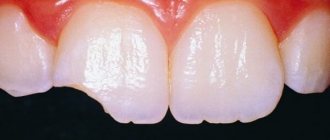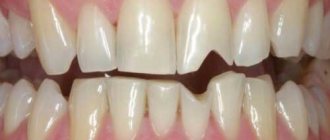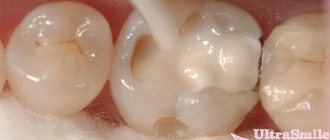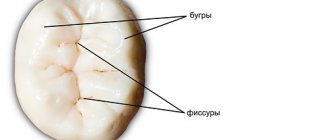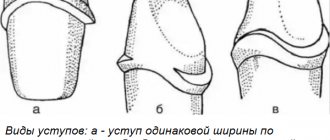In what cases is it necessary to install a filling?
The installation of restorative material is carried out not only in the treatment of carious lesions. The procedure is also performed when:
- presence of chips and cracks;
- elimination of consequences after mechanical damage;
- intense loss of hard tissues, leading to almost complete wear of the upper part of the teeth (for example, due to involuntary grinding of the jaws).
It is worth noting that any dental clinic performs filling only in cases where the destruction of the coronal part is insignificant. If the surface of the tooth is damaged by more than a third, it is replaced with an artificial substitute - a prosthesis.
The use of modern materials helps restore the beauty of the smile and chewing function, and also prevents further destruction of the mineralized coating.
Regular dental examinations and professional hygiene
Even the most efficient and disciplined person needs additional dental care. Self-cleaning is not enough, and once every 6 months we recommend undergoing a preventive examination and comprehensive professional oral hygiene. This procedure includes cleaning teeth from plaque using ultrasound, special AirFlow technology and subsequent polishing of teeth and fillings with a special paste. This is very useful not only for teeth, but also for fillings. This polishing removes scratches, food pigments and restores the original shine.
What types of fillings are there?
Depending on the period of use, temporary and permanent fillings are distinguished. The first ones are placed during treatment. For example, they cover a tooth for a while in order to understand whether the nerve is affected by caries or not. A temporary filling is also used to secure medications placed in a diseased tooth, or to secure arsenic after depulpation. After two weeks, temporary materials are replaced with permanent ones. The latter can last for years.
In modern dentistry, the following types of fillings are distinguished:
- Cement fillings are a budget option. They are difficult to grind, look unnatural and can cause destruction of the teeth they interact with.
- Metal (almagamic). They are made from an alloy of silver and copper, are characterized by increased strength, but also stand out against the background of the rest of the jaw. Often, fillings of this type are installed on teeth located further than the incisors.
- Composite fillings. They have a paste-like consistency and are applied in layers, so working with them does not cause much difficulty. Special ultraviolet light is used to fix composite materials. The variety of the palette allows you to choose a shade that will not differ from the native enamel, which is why composites are widely used for the restoration of anterior teeth.
- Ceramic fillings. In appearance and composition, they are as close as possible to the natural coating of teeth. Their production takes some time, so the fixation of the material is carried out in several stages. Ceramics are resistant to temperature changes. Its main advantage is also aesthetics.
Possible consequences of an over-inflated filling:
- When the filling is too high, an increased load falls on the tooth; when the mouth is closed, the teeth of the opposite jaw put pressure on the filling. Thus, chronic tooth injury occurs. Constant pressure on the tooth can lead to traumatic pulpitis and periodontitis. As a result, the tooth will need to be depulped.
- With constant increased load on the filling, there is a risk of its chipping, as well as the chipping of the tooth wall.
- If, when closing the mouth, the teeth close together on one side (on an over-inflated filling), but the teeth on the other side do not close, then a kind of “distortion” occurs; the lower jaw may move to the side when closing the mouth. If you tolerate such an inconvenience, your body will eventually get used to it and stop noticing it. However, the problem will remain. The unusual position of the lower jaw when closing the teeth and blocking its lateral displacements can lead to diseases of the temporomandibular joints. Pain, crunching, clicking in the joints of the lower jaw - all this can be a symptom of a disease, which can be caused by over-inflated fillings.
What types of fillings are better?
Many dentists recommend installing fillings made of light-curing composite. They are characterized by increased strength and durability, and look natural. Composite fillings are suitable for filling cavities in distant teeth and restoring carious cavities, as well as for treating erosions of hard tissues. Their service life is 5 years.
Glass ionomer cement, which is a hybrid of acrylic and silicate components, is also considered a good choice for filling. Glass ionomer combines well with natural coatings and other established types of fillings; it is suitable for treating destructive processes of the tooth, filling the anatomical space under the roots, and preparing the cavity for further orthopedic manipulations.
What are fillings and how do they appear in your mouth?
I bet you have at least one dental filling. If not, then you know exactly what it is. Teeth after damage by caries and removal of the affected areas need to be restored. Doctors most often do this by filling the resulting defect with a light-curing composite filling material. Composite fillings are a perfect color match and are quite durable, but will not last forever. As a result, a “filling” is a composite material that the doctor used to close the cavity in the tooth after removing carious tissue. The average service life of a filling is 3-5 years.
How is the filling installed?
The fixing of the restoration material always follows the same pattern:
- First, the doctor injects into the tissues located around the damaged area.
- When the medicine begins to act, the specialist cleans the cavity from the remains of dead tissue, darkened mineralized parts and dentin, and gives it the desired shape and depth.
- The doctor then examines the pulp. If the connective tissue is not damaged, the prepared area is treated with an antiseptic. If the pulp is in a state of inflammation, then the dentist removes it from the tooth cavity and then fills the canals.
- After the above manipulations, the cavity is dried. Then special antimicrobial and insulating gaskets are placed in it.
- At the final stage, filling is carried out. At the end of the operation, the installed material is ground for comfortable closure of the jaws and polished.
Is the filling in the way? Don't be patient!
Has it ever happened that the doctor treated your tooth, put a filling, and when you came home, you felt that the filling was too high, there was discomfort when closing your mouth, and the rest of your teeth did not close?
Unfortunately, this situation occurs quite often. After placing the filling, the doctor polishes it according to the bite: gives the patient a carbon copy to bite, asks if the filling is in the way, adjusts it and polishes it. However, even an extra millimeter of filling, invisible to the doctor’s eye, can be felt by the patient as something foreign on the tooth and cause discomfort. While local anesthesia is in effect and the feeling of numbness remains, it is difficult for the patient to determine whether the filling is in the way. Only when the anesthesia finally wears off does the patient realize that it is inconvenient for him to close his teeth.
In such cases, many people think: “Nothing, it will wear off over time, I’ll get used to it!” Under no circumstances should you endure and wait for the filling to “settle down”, wear off, etc. Modern filling materials are very durable and resistant to abrasion. It can take years for the extra millimeter of filling to wear off. You shouldn’t get used to discomfort either, because... overestimation of the tooth can lead to negative consequences. It is also important that the filling does not block the movements of the lower jaw. You can check this this way: close your teeth, try to move your lower jaw left, right, forward (without opening your mouth wide). If the movements are the same as before the filling was placed, then everything is fine. If you feel that the filling prevents you from moving your lower jaw in any direction, be sure to inform your doctor about this.
After teeth filling
In some cases, after applying a filling, the sensitivity of the sealed tooth to external factors may increase: it may “ache” unpleasantly with any temperature change or when air enters. This most often happens when using composite materials. If the tooth remains sensitive two weeks after treatment, you should immediately consult a doctor.
A common cause of pain that occurs immediately after the anesthetic wears off can also be an excessive filling height. In this case, it should be reduced by the dentist.
The application of a filling is always accompanied by final grinding, during which the edges may remain sharp. Due to the action of the injection, this is often not felt immediately. If you notice protruding edges after the anesthetic has worn off, you should contact a dental clinic as soon as possible and make an appointment to straighten the tooth surface.
Service life and replacement of fillings
According to medical statistics, a filling should last from 3 to 5 years. And if the doctor can show you during the examination that there are signs of destruction and separation of material from the surface of the tooth, such a restoration should be replaced immediately. This way you will avoid the danger of secondary caries under the filling, which usually develops asymptomatically and does not manifest itself in any way, but can damage most of the tooth.
We regularly talk to our patients about how to extend the life of their fillings, provide free preventive examinations and explain the importance of professional cleaning. The doctor and the patient in tandem help the fillings last longer, which means they bring more comfort to the patient’s life and save his time and money.
Rules for caring for fillings
Despite the fact that many fillings can theoretically last for years, it is recommended to change the materials every 10-12 years. It is recommended to visit a doctor once every six months for hygiene measures. You should also make an appointment with a doctor if:
- short-term pain in the treated area;
- detection of cracks;
- presence of a chip in the filling material.
The dentist can easily replace a bad filling with a new one.
If there is a large amount of restoration material in the cavity, you can ask the specialist to prescribe a gel with a high fluoride content. Its regular application will help strengthen the hard surface and prevent caries from forming again. Filled teeth may also be coated with fluoride varnish during the examination.
At home, it is recommended to use mouth rinses. With their help, you can significantly reduce the number of microbes that cause caries.
Summarizing the above, I would like to note that filling is a serious procedure. To prevent dental treatment under anesthesia from ending with repeated fillings and a double waste of time and money, you should seek help only from reliable, experienced specialists.
What is important in the first 2 weeks after placing a filling?
Immediately after the filling is placed, the material is not yet completely polymerized and may have micropores that are easily filled with coloring food products. This could be wine, chocolate, berries and other “bright” foods. Try not to eat such tasty things and not drink red wine for the first two weeks, but if it is simply impossible, immediately after eating, rinse your mouth with water and, if possible, brush your teeth with a toothbrush and toothpaste. After 2 weeks, a high-quality filling will no longer be stained.
What does careless filling lead to?
Dental filling is the most common and probably familiar dental treatment procedure to every person. But you don’t even suspect how many problems an incorrectly installed filling can cause.
For example, she can:
- simply fall out in a few weeks, or even by evening
- cause discomfort while eating and even at rest
- injure the gums and lead to periodontitis (inflammation of the gums)
Moreover, in some cases, improper filling can even cause jaw pain and headaches!
This is exactly the story our patient told.
“Some time after installing fillings on all the chewing teeth, I noticed that the lower jaw seemed to be “moving” from side to side.
Soon, the unpleasant sensations were supplemented by pain in the cheekbones, and then in the back of the head; while eating, it was painful even just to open my mouth.
As it turned out, all my fillings were made flat! And this led to a violation of the natural position of the jaw. I couldn’t even imagine that this could happen!”
To avoid trouble, remember -
